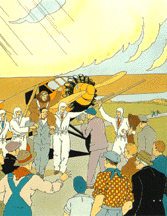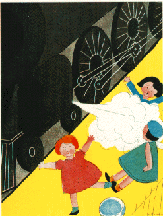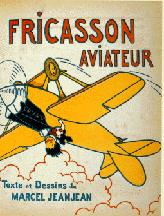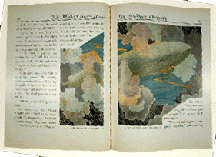 The daring aviators get the media
attention, but it's the cheerful airplane who has brought them
safely to land in Wallace Wadsworth's The Modern Story Book, illustrated by
Ruth Eger (New York; Chicago: Rand McNally, 1931).
The daring aviators get the media
attention, but it's the cheerful airplane who has brought them
safely to land in Wallace Wadsworth's The Modern Story Book, illustrated by
Ruth Eger (New York; Chicago: Rand McNally, 1931). The University of Chicago Magazine June 1995
The University of Chicago Magazine June 1995
 The daring aviators get the media
attention, but it's the cheerful airplane who has brought them
safely to land in Wallace Wadsworth's The Modern Story Book, illustrated by
Ruth Eger (New York; Chicago: Rand McNally, 1931).
The daring aviators get the media
attention, but it's the cheerful airplane who has brought them
safely to land in Wallace Wadsworth's The Modern Story Book, illustrated by
Ruth Eger (New York; Chicago: Rand McNally, 1931).
 The locomotive hero
of Roger Duvoisin's All Aboard! (New York: Grosset and
Dunlap, 1935) can't resist the urge to show off in front of three young
girls: "I let go a blow of steam which made a very big noise."
The locomotive hero
of Roger Duvoisin's All Aboard! (New York: Grosset and
Dunlap, 1935) can't resist the urge to show off in front of three young
girls: "I let go a blow of steam which made a very big noise."
"Planes, Trains, and Automobiles: The Transportation Revolution in Children's Picture Books," at the Regenstein Library until July 10, features 150 books from the University's Encyclopaedia Britannica Collection of Literature for Children and from Harris's own personal collection. In organizing the exhibit, Harris focused on how artists, writers, and publishers in the U.S., Russia, France, and England have responded to transportation's ongoing transformation.
Invention by invention, writes Harris in the exhibition catalog, autos, airplanes, and spaceships have "continued to thrust transport to the very center of modern consciousness and to make many of its vehicles central symbols of modernity."
Although the first children's book in English to use trains, steamboats, or horseless carriages as its central subject has yet to be identified, there's ample proof that illustrated references began to pop up in ABC books and other types of instructional literature almost at once. With time, those references became more prominent.
By the 1880s, English titles like Abroad and London Town emphasized the domestic side of modern transportion. These books' middle-of-the-road scenes, writes Harris, show "nicely dressed and well-behaved children exploring the delights of travel and the pleasures of tourism."
At the other end of the spectrum were the dime-novel series that flourished from the 1860s through the first decades of this century. Books like The Outlaws of the Air and Ralph on the Overland Express (subtitled The Trials and Triumphs of a Young Engineer) and The Motor Cycle Chums' Whirlwind Tour were short on illustrations but, writes Harris, "nonetheless linked the life of mechanized transport with romance, heroism, and personal enterprise."
After the First World War, a stream of travel posters, brochures, and advertisements for railroads, ocean liners, cars, and aviation companies offered up image after image touting travel and tourism through the appeal of speed, power, and adventure. As new printing techniques, unusually shaped books, and other illustrative innovations traveled back and forth across the Atlantic, another kind of image -- anthropomorphic machines, whose precedents ranged from 19th-century French caricatures to the illustrations accompanying Frank L. Baum's Oz books -- gained ground.
The first mechanical heroes owed much to the talking animals that preceded them in juvenile literature -- and whom they never fully replaced. As Harris notes, "Bookstore shelves persist in featuring life stories of lovable, heroic, mischievous, or far-sighted bears, owls, cows, spiders, horses, pigs, foxes, and lions."
Now the cautionary critters had machines -- "not in the interest of satire or fantasy but for the sake of reader interest and intense moralizing" -- for company. Powerful symbols of the modern world, transport machines were recast with human qualities, many delivering a moral message. "Huffing and puffing, smiling, weeping, grimacing, frowning, yawning, complaining, and above all, straining to be better and to perform good deeds," Harris writes, "these protagonists are, like many children, occasionally misunderstood, mistrusted, and unjustly maligned.
"Quite a number of them suffer some handicap: they are underpowered, or wrongly placed." Take Lucy, the blue caboose. In Lydia and Don Freeman's 1951 tale, Chuggy and the Blue Caboose, Lucy gets snubbed by a clique of aristocratic Tuscan Red cars. "We come from a long line of freight cars," one of her persecutors sniffs, "and she comes from only a short circus train!"
Then consider the company of British locomotives detailed in the books of the Rev. William Awdry. Thomas the Tank Engine came first, in the mid-1940s, followed by Henry the Green Engine, Percy the Small Engine, and some 40 more. Their adventures have happy endings and a lesson to be learned: Do your best to be a "Really Useful Engine."
Little Toot, Jaspar, and the Taxi that Hurried. Sparky. Chuggy. Tootle. Choo Choo. As trains, cars, planes, and boats took on larger roles in childrens' games, toys, and lives, more books began to turn machines -- transport and otherwise -- into individuals. "As early as 1932," Harris writes, "electric fans named Fanny Blowhard, file cabinets, desks, and elevators were chatting easily with one another.
"Domesticated machines constituted one way to adapt children to an increasingly mechanized world, introducing them to a sphere of action whose complexity and depth seemed to rival that of natural creation itself."
Providing a counterpoint were those illustrators who reacted to the powerful symbols in another way. Abandoning realistic representation, they used intense colors and distorted perspective to explore the sensations of speed and height offered by ultra-modern travel. Sometimes such stories centered around a flight to an exotic place, sometimes on the machine's underlying power.
For example, Roger Duvoisin's All Aboard! follows a streamliner on its travels. The train's journey is represented as a child might experience it: in shifting colors, shapes, and sounds. Lokomotywa, by the Polish team of Jan Lewitt and George Him, epitomized the growing abstraction of children's illustration. Rather than "domesticating a large beast by giving it human features and feelings," writes Harris, such books accepted "the conditions the great machine set."
From steamboats to computerized spaceships, transportation technology still rushes forward, creating new machines -- and new children's books.
"It may be difficult to endow rockets and computers with the endearing personalities that locomotives, taxis, and tugboats could bear," Neil Harris admits, "but that has not stopped filmmakers and writers of science fiction. It is to be expected that future illustrators will do their best to adapt and domesticate these apparently fearsome and complex instruments to the service of their parables and fantasies, and do the same with other machines whose outlines we can only dimly surmise." -- M.R.Y.
 Marcel Jeanjean's Les adventures de Fricasson (Paris: Union Latine
d'Editions, 1925) celebrates a daredevil pilot.
Marcel Jeanjean's Les adventures de Fricasson (Paris: Union Latine
d'Editions, 1925) celebrates a daredevil pilot.

 Faster is better in Denison
Budd's Railroad ABC(New York: Franklin Watts, 1944) (TOP) and Diana Ross's The
Little Red Train Goes to Market (London: Faberand Faber, 1946), illustrated
by Leslie Wood.
Faster is better in Denison
Budd's Railroad ABC(New York: Franklin Watts, 1944) (TOP) and Diana Ross's The
Little Red Train Goes to Market (London: Faberand Faber, 1946), illustrated
by Leslie Wood.
 The Stubborn Dirigible (his friends and readers call him "Zep") battles
his way through a terrible storm in The Modern Story Book.
The Stubborn Dirigible (his friends and readers call him "Zep") battles
his way through a terrible storm in The Modern Story Book.
 The deep
tones of the motor boat in C. B. Fall's The Modern A B C Book (New
York: John Day, 1930) come from a four-color process developed by the
Jersey City Printing Company. How modern is Fall's alphabet? "K is for
Kodak."
The deep
tones of the motor boat in C. B. Fall's The Modern A B C Book (New
York: John Day, 1930) come from a four-color process developed by the
Jersey City Printing Company. How modern is Fall's alphabet? "K is for
Kodak."